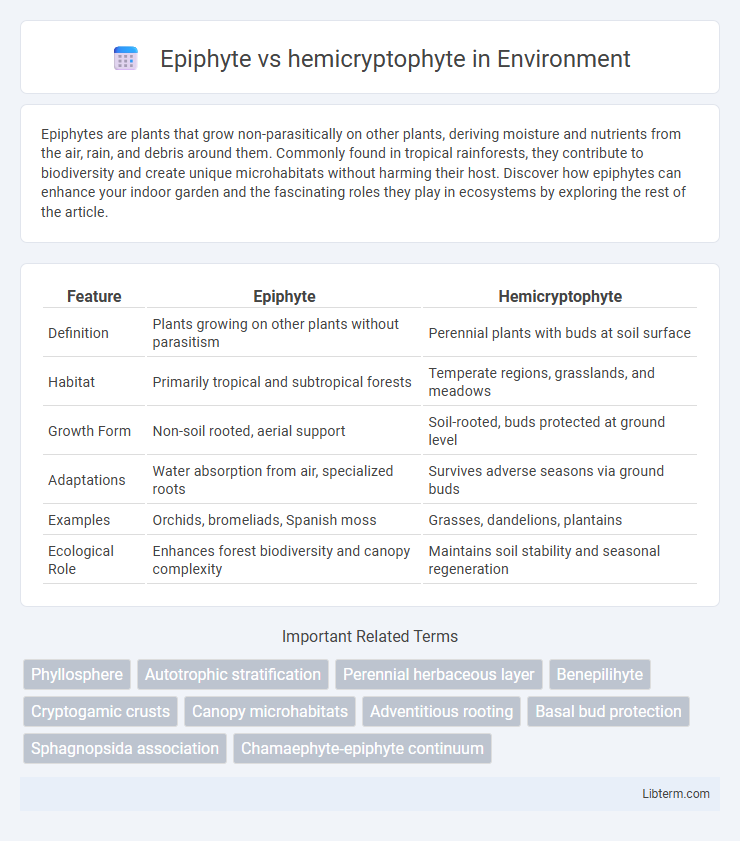Epiphytes are plants that grow non-parasitically on other plants, deriving moisture and nutrients from the air, rain, and debris around them. Commonly found in tropical rainforests, they contribute to biodiversity and create unique microhabitats without harming their host. Discover how epiphytes can enhance your indoor garden and the fascinating roles they play in ecosystems by exploring the rest of the article.
Table of Comparison
| Feature | Epiphyte | Hemicryptophyte |
|---|---|---|
| Definition | Plants growing on other plants without parasitism | Perennial plants with buds at soil surface |
| Habitat | Primarily tropical and subtropical forests | Temperate regions, grasslands, and meadows |
| Growth Form | Non-soil rooted, aerial support | Soil-rooted, buds protected at ground level |
| Adaptations | Water absorption from air, specialized roots | Survives adverse seasons via ground buds |
| Examples | Orchids, bromeliads, Spanish moss | Grasses, dandelions, plantains |
| Ecological Role | Enhances forest biodiversity and canopy complexity | Maintains soil stability and seasonal regeneration |
Introduction to Epiphytes and Hemicryptophytes
Epiphytes are plants that grow non-parasitically on other plants, deriving moisture and nutrients from the air, rain, and debris, commonly found in tropical rainforests. Hemicryptophytes are perennial plants with buds situated at soil level, protected during unfavorable seasons, and typical in temperate climates. Both epiphytes and hemicryptophytes exhibit adaptive strategies for survival, differing primarily in their growth habits and ecological niches.
Defining Epiphytes: Characteristics and Adaptations
Epiphytes are plants that grow non-parasitically on other plants, primarily trees, deriving moisture and nutrients from the air, rain, and debris accumulating around them. Characterized by specialized adaptations such as aerial roots, water storage tissues, and the ability to thrive in nutrient-poor environments, epiphytes play a critical role in forest ecology by increasing habitat complexity and biodiversity. In contrast to hemicryptophytes, which have perennating buds at soil surface level, epiphytes exhibit unique morphological and physiological traits enabling arboreal lifestyles without soil dependence.
Understanding Hemicryptophytes: Key Features
Hemicryptophytes are perennial plants with buds situated at ground level, enabling survival through unfavorable seasons by protecting meristematic tissues under soil or leaf litter. These plants often exhibit adaptations such as rosette formations and seasonal leaf dieback, optimizing energy conservation and regrowth. Understanding hemicryptophytes' key features aids in ecological classification and reveals their role in temperate biomes and grassland ecosystems.
Habitat and Distribution Comparison
Epiphytes predominantly inhabit tropical and subtropical rainforests, growing on host plants without extracting nutrients, thriving in humid, shaded canopy layers across Central and South America, Southeast Asia, and Africa. Hemicryptophytes are commonly found in temperate regions with seasonal climates, such as grasslands and meadows of Europe, Asia, and North America, surviving harsh winters by maintaining buds at soil level. The distribution of epiphytes relies on stable, moisture-rich environments for aerial nutrient absorption, whereas hemicryptophytes adapt to fluctuating climates by utilizing soil-based regeneration strategies.
Growth Strategies in Epiphytes and Hemicryptophytes
Epiphytes exhibit specialized growth strategies such as aerial root systems and water storage adaptations to thrive on host plants without soil contact, maximizing light access and nutrient absorption from the atmosphere. Hemicryptophytes develop regenerative buds at or just below the soil surface, enabling resilience against environmental stresses like frost and grazing while promoting rapid seasonal growth. These growth strategies reflect distinct ecological adaptations where epiphytes optimize vertical space exploitation, and hemicryptophytes enhance survival through subterranean bud protection.
Ecological Roles and Significance
Epiphytes play a vital ecological role by growing on other plants, mainly trees, to access sunlight without harming their hosts, significantly contributing to biodiversity and nutrient cycling in forest canopies. Hemicryptophytes, with perennating buds situated at the soil surface, are crucial for ecosystem stability as they survive adverse conditions and enable rapid regeneration, supporting soil conservation and succession processes. Both plant types influence microhabitats and ecological dynamics, but epiphytes primarily enhance vertical habitat complexity, while hemicryptophytes stabilize ground-level vegetation layers.
Water and Nutrient Acquisition Differences
Epiphytes obtain water and nutrients mainly from the air, rain, and debris accumulating around their roots since they grow attached to other plants and lack soil contact. Hemicryptophytes, with perennial buds at or just below the soil surface, absorb water and nutrients directly from the soil through their root systems, benefiting from ground-based resources. These contrasting acquisition strategies highlight epiphytes' adaptations to aerial environments versus hemicryptophytes' reliance on soil ecosystems.
Examples of Epiphyte and Hemicryptophyte Species
Examples of epiphyte species include orchids such as *Phalaenopsis*, bromeliads like *Tillandsia*, and ferns such as *Platycerium* that grow non-parasitically on other plants. Hemicryptophyte species comprise grasses like *Festuca ovina*, perennial herbs such as *Achillea millefolium* (yarrow), and rosette-forming plants like *Plantago major* (common plantain), which survive unfavorable seasons with perennating buds at or just below the soil surface. These classifications highlight adaptation strategies in different ecological niches, with epiphytes thriving in forest canopies and hemicryptophytes enduring ground-level conditions.
Evolutionary Adaptations and Survival Benefits
Epiphytes have evolved specialized root systems that absorb moisture and nutrients directly from the air, enabling survival in nutrient-poor environments and maximizing light access by growing on host plants. Hemicryptophytes possess buds at or just below the soil surface, allowing them to withstand seasonal climatic extremes and regenerate after adverse conditions such as frost or drought. These evolutionary adaptations provide epiphytes with vertical habitat exploitation advantages, while hemicryptophytes benefit from enhanced resilience and regrowth capacity in temperate ecosystems.
Conclusion: Ecological Impact and Conservation Considerations
Epiphytes, thriving on host plants without parasitism, enhance biodiversity by creating unique microhabitats and supporting complex ecological networks in forest canopies. Hemicryptophytes contribute to soil stabilization and nutrient cycling through their perennial growth at soil surfaces, playing a crucial role in temperate ecosystem resilience. Conservation strategies must prioritize habitat preservation for epiphytes affected by deforestation and address land-use changes that threaten hemicryptophyte populations to maintain overall ecosystem health.
Epiphyte Infographic

 libterm.com
libterm.com